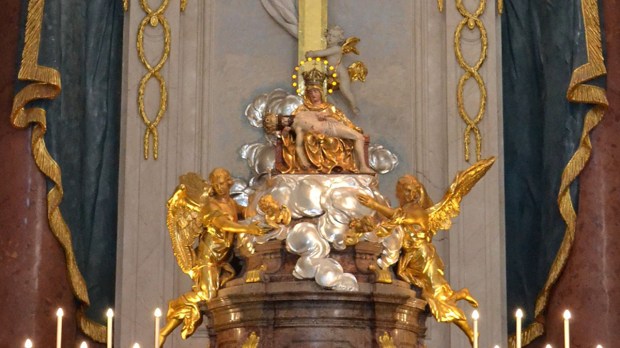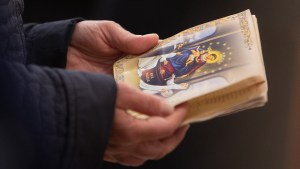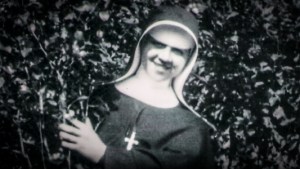In the 1950s, the communists sought to suppress the Marian shrine of Šaštin, as they did with other shrines in Slovakia. Today, Our Lady of the Seven Sorrows, patroness of the country, accompanies the nation’s families and those suffering in the pandemic.
This is what Fr. Martin Kramara, spokesman for the Bishops’ Conference of Slovakia, declared during a virtual meeting with journalists from Rome organized by ISCOM, in connection with the preparation of Pope Francis’ apostolic journey to Slovakia (September 12-15).
“With Mary and Joseph on the way to Jesus”: this is the motto for Pope Francis’ visit to Slovakia, which will be in the midst of a two-stage journey. The first will take place in Budapest, Hungary; there, the pope will preside at the Closing Mass of the 52nd International Eucharistic Congress. The second will take place in Slovakia, where he will visit Bratislava, Košice, Prešov and Šaštin.
Faith despite communism
“The communists took men and women religious to concentration camps. The monasteries were closed. They also tried to wipe out the Marian shrine in Šaštin. The communists were pressuring Slovaks not to visit the shrine. But, this was not enough; it has always been a place loved by the people,” said Fr. Kramara.
He added that the shrine is a symbol of peaceful resistance rooted in the values of faith: “It shows that we are not afraid.”
These words echo those of St. John Paul II when he visited the shrine on July 1, 1995; he compared it to the upper room where the apostles prayed with Mary and received the Holy Spirit, being transformed from being fearful to being courageous witnesses.
A final stop
On the last day of his Apostolic Visit (Wednesday, September 15) the Latin American Pope will preside over Mass at the National Shrine of Šaštin, after which, at 1:30 p.m., he will bid farewell at the International Airport of Bratislava where he will board the plane that will depart for Rome at 1:45 p.m. local time.
The spokesman for the Slovak Bishops’ Conference said that this is a significant last stop, given the history of the shrine.
A shrine for marriages
Here, in 1564, a woman named Angelica was abandoned by her husband, a Hungarian nobleman named Imarich Czobor, who hated her. Heartbroken, sad, and now abandoned, Angelica prayed with all her might and asked for the intercession of the Virgin Mary, while promising to erect a statue in honor of Our Lady of Sorrows if she received the miracle she sought.
Her husband had an unexpected reaction: he returned to look for her and asked for her forgiveness. She kept her promise, and subsequently the place became a place of pilgrimage, even visited by Mother Teresa of Calcutta.
Up until the appearance of COVID-19, “Slovaks flocked to the shrine every September 15, the feast of Our Lady of Sorrows, to pay homage to their national patroness who has been by our side in difficult times,” said Fr. Kramara.
A national patroness
“Angelica kept her promise. Many people say that their prayers have been heard,” he added. Miraculous healings have been reported around the shrine, which were recognized in 1732 by the bishop of Esztergom. In 1927, Pius XI proclaimed Our Lady of Sorrows the patroness of Slovakia.
The Soviet government tried to suppress the popular devotion, turning the shrine into a military barracks. The attempt failed; the images of the Mass presided over by John Paul II in 1995 at the shrine, after the fall of the Soviet regime, with the presence of more than 200,000 faithful from all over Slovakia, were a confirmation of this long history of unwavering popular piety. The resilience of this devotion reflects the legacy of Sts. Cyril and Methodius (in the 9th century), also known as the apostles of the Slavs, missionaries of Christianity in those lands.
John Paul II and Our Lady of the “Seven Sorrows”
Pope John Paul II also had ties to the devotion of Mary’s “Seven Sorrows,” which he mentioned in particular in his first homily in Slovakia during his 1995 apostolic journey, six years after the Fall of the Berlin Wall.
“This shrine,” said the Polish pope, “preserves the memory of all that makes up your lives: joys, but also sorrows and sufferings, which have not been lacking in your history, as in that of every person and nation of the earth. It is good that we have someone with whom to share our joys and sorrows. It is good that in your great Slovak family there is a Mother to whom you can confide and entrust your sorrows and hopes.”
The pope, who was instrumental in the downfall of communism, said that Our Lady of Sorrows, the Mother of Seven Sorrows, is “the Mother whose heart, at the foot of the Cross, was pierced by the seven swords of suffering, as tradition says.”
This Marian shrine is where the Slovak people go on pilgrimage in search of “consolation for their not at all easy existence, especially in the periods most marked by suffering,” he noted. “Here Mary, the Mother of Christ, wants ‘to be a mother to you’; she wants you to be especially sincere and simple with her. Here is her dwelling place and, thanks to the fact that there is a house of the Mother of God in your Slovak land, none of you is homeless. Everyone can come here and feel at home in the Mother’s house.”
Pope Francis: Our Lady of Sorrows during the pandemic
Pope Francis has said that, as people think about the aftermath of the pandemic and “all the problems that will arise: problems of poverty, work, hunger …”, we should pray to Our Lady of Sorrows. “This veneration of the people of God has existed for centuries. Hymns have been written in honor of Our Lady of Sorrows: she was at the foot of the cross and they contemplate her there, suffering. Christian piety has collected Our Lady’s sorrows and speaks of the ‘seven sorrows.’”
The pope detailed the meaning of the seven sorrows:
- The first, just 40 days after the birth of Jesus, is Simeon’s prophecy that speaks of a sword that will pierce her heart (see Lk 2:35).
- The second sorrow is the flight to Egypt to save her Son’s life (see Mt 2:13-23).
- The third sorrow, those three days of anguish when the boy remained in the temple (see Lk 2:41-50).
- The fourth sorrow, when Our Lady meets Jesus on the way to Calvary (see Jn 19:25).
- The fifth sorrow of Our Lady is the death of Jesus, seeing her son there, crucified, naked, dying.
- The sixth sorrow, Jesus’ descent from the cross, dead, when she takes Him in her arms as she held Him in her arms more than 30 years before in Bethlehem.
- The seventh sorrow is Jesus’ burial.
Pope Francis prays to Our Lady of Sorrows every evening when he prays the Angelus, and comments that he prays the Seven Sorrows “as a remembrance of the Mother of the Church, how the Mother of the Church gave birth to us all with so much pain.”



